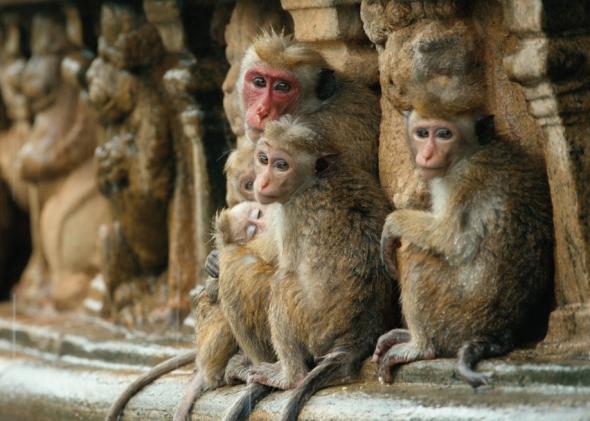In Disney’s new documentary Monkey Kingdom, the animals are characters: The trailer focuses on a macaque dubbed “Maya,” and describes her “dreams” for her son. This approach isn’t surprising—wildlife docs have used the “animals are just like us” shtick for more than 50 years. But with more recent commercial successes like March of the Penguins, cute, fuzzy animals in documentaries are now more likely than ever to get the full anthropomorphic treatment: to be given names, to be supplied with human aspirations, to go on some intrepid journey ideally narrated by a famous human like Tina Fey or Morgan Freeman. It’s now almost impossible to make a wildlife documentary without a dose of anthropomorphism—it influences countless filmmaking decisions, from pitching ideas to editing.
Producers are probably right to assume that few people want to sit in a theater and watch animals doing animal stuff for two hours; viewers need to emotionally invest. It’s a consideration that even affects what kinds of animal documentaries get funded: Bob Landis, the Emmy Award–winning wildlife cinematographer behind In the Valley of the Wolves, told me that if one of his pitches gets rejected, it’s often because the sequences don’t come together to make a strong enough “story arc.”
In making She Wolf, Landis said that producers wanted his film to focus on the early footage he caught, which centered on a dramatic alpha female’s triumphant rise to power as she raised her own pack. Producers were less eager for later footage, when she behaved more like a normal wolf. They were also less interested in the time when she left the park in search of food—which ultimately resulted in her getting shot and killed. That part was Landis’ favorite footage. But the producers wanted to focus mainly on the alpha female’s ascendancy, which they thought made a more compelling plot.
“We just assume wolf society is similar to human society,” Landis said, which can sometimes be misleading. In the human world, Landis notes, prominent alpha females may still be relatively rare—but in the animal world, they’re pretty common. “You can’t avoid some anthropomorphism,” Landis said. But projecting emotional narratives that “aren’t reasonable, or so far beyond reality, is something I try to prevent. … otherwise you get into the Disney approach that I just really abhor.”
Disney has spent decades perfecting its anthropomorphic formula, starting with the legendary True-Life Adventures series, which began in 1948. As one critic described: “You take a wealth of astonishing wildlife cinematography, assign human names and traits to the animals you’ve filmed, fabricate an engaging storyline around their exploits (preferably involving a mother and newborn) and edit your footage together to serve that story, then hire a seasoned comic actor to deliver the lively narration.” The approach was a welcome shift—before that, animals were commonly portrayed as hunting targets, or staged to look like terrifying beasts. (In 1926, The Guardian notes, zoo-goers were disappointed to find out that Komodo dragons are pretty lazy, after watching a documentary that used editing and staging to make them seem scarier.) Filmmaker Chris Palmer has noted: “If you see a bear feeding on a deer carcass in a film, it is almost certainly a tame bear searching for hidden jellybeans in the entrails of the deer’s stomach.”
Amid the broader Disney-ification of wildlife documentaries, today’s filmmakers must decide which techniques they consider kosher, and where they draw the line. “In filming wildlife, you can’t have your animals go back and repeat sequences,” Landis said. And sometimes, this can mean you can’t get a close-up of a behavior you saw the animal do. But there are ways to fudge it a bit—for instance, in making The Rise of Black Wolf, there were actually three different black wolves used to represent one wolf. “We were very conscious of our editing,” Landis said, to make sure that the trick was only used to reproduce behaviors that had actually happened, rather than to inject behaviors that hadn’t really occurred. Music can help too: In In the Valley of the Wolves, Landis said that the Scottish music in the film helps emphasize parallels between clan wars and the clash between wolf packs.
Judy Irving, director of The Wild Parrots of Telegraph Hill, has no problem characterizing animals as creatures with emotions. Her documentary follows Mark Bittner, an unemployed musician who bonds with a flock of wild parrots in San Francisco. Bittner had come up with all sorts of stories about the birds, based on their apparent relationships and character traits. Bittner named one particular parrot pair “Picasso” and “Sophie”—describing them as a “big lug,” and a “little French girl.” “He had this whole story made up about her,” Irving said, “and I thought, ‘Oh, this is so great, I hope I can get a shot of Picasso and Sophie where they kind of look like that.’ ” So she was constantly on the lookout for ways to “illustrate [these] stories” about the birds.
And when she started filming her newly released documentary Pelican Dreams, she knew off the bat that she needed a shot of a pelican’s first flight. “In the movie, when you see these birds, you can tell they’re scared. They’re flapping, flapping, flapping, but they don’t want to take off—you know it’s too scary.” Editing the footage is just a matter of putting it all together to make a seamless, meaningful story. And for the viewer, watching the birds finally take flight, after all the frenzy and struggle—it does, Irving said, “create a huge amount of empathy.”
